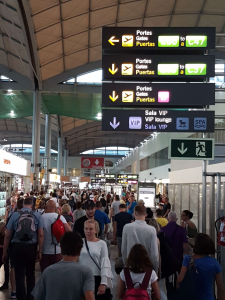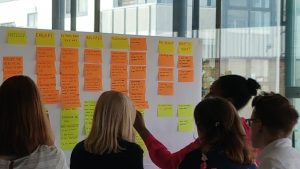Ten hidden benefits of customer journey mapping
The benefits of customer journey mapping are well documented; it’s an incredibly valuable exercise that gives the business a shared understanding of what it’s like to be a customer. And, therefore, a clear picture of what should be celebrated, what should be done differently and why.
Journey mapping is a means to an end. It’s not, as some people see it, about having a pointless happy-clappy day with Post-it notes and Sharpie pens.
Done effectively and on an ongoing basis, what customer journey mapping tells you can be one of the most effective strategic and economic tools a business has in its armoury. But not everyone sees it that way and as CX professionals we often need to help sceptical stakeholders ‘get it’.
So, for what it’s worth and to help anyone trying to convince a non-believer to begin mapping customer journeys, I’ve put together a list of some of the additional pleasant surprises – sorry, “commercial benefits” – journey mapping delivers.
1 Catalyst. It’s a great place to start.
Companies often struggle to get momentum behind a fledgling customer experience programme. If you do nothing else in the name of customer experience, map a customer journey and see where it takes you.
The beauty of journey mapping is that it’s easy to do and even just a couple of hours or a day’s workshop can set things on the right path.
It will challenge dangerously complacent beliefs that there is no burning platform. And even if it becomes apparent that today’s customer experience isn’t inherently broken it will provide plenty of ideas for how to keep up with expectations in future.
2 Engagement. Hey presto, you’ve created a CX focused, cross-functional team.
At a recent workshop I facilitated, one participant stopped in her tracks when telling her persona’s story to the group. She observed that this was the first time that organisation had brought everyone together who had some involvement across the entire journey. Pennies dropped, dots were joined and new relationships created there and then.
They’ve stayed together as a group ever since and have created mini-task forces for other journeys.
Involvement in these types of workshops creates excitement but also an expectation that things will change. That has to be managed carefully but what you do have now is an army of internal CX champions who will help spread the word.
3 Value. The outputs have all sorts of uses, just make sure they’re not filed away.
The biggest risk to journey mapping is that once the journeys are mapped, the persona stories are told and the findings are documented, they get filed away and never see the light of day.
Make it a living beast so it never fades away. Put the journey on a wall or on the intranet so it’s visible to everyone. It’s a great opportunity to get thoughts from other employees who can to wander past and add their thoughts over a cup of coffee. Keep it alive, use it to generate interest and action.
It prompts all sorts of conversations about the issues and opportunities. And it’s also a great visual to show new employees what their customers experience too.
4 Simplicity. As they say, simplicity is a very sharp knife.
It doesn’t have to be complex to be value-creating. As with many things in life it’s easy to over-engineer. Journey mapping does need to work hard to be from a customer’s perspective but often the simpler the structure and framework the better.
One client told me they were keen to do some mapping but couldn’t take the team out for a whole day. Instead, they took a bit of time in a team meeting; better than nothing. The format was quick but follows the same approach as a full workshop; sketch out what the customer is trying to do and why, then across the stages, look at what they are thinking, doing and feeling.
Then ask what you measure; do you know how well you do the most important things?
Review what you’ve written down and agree some actions. First journey map, done.
5 Themes. Over time, helpfully, common issues rise up to the surface.
Journey maps should never be reviewed in isolation. Whether you run one journey from the perspective of several personas or you look at multiple journeys, it’s very likely you’ll find common threads emerging.
So, while one specific issue raised may not be critical to that journey itself, we should take notice when that same issue appears in other journeys for other customers, employees or third parties.
A quick example from a mapping programme I ran late last year. Although they weren’t cited as major challenges in their individual workshops, it became apparent in every one of a dozen or so sessions that three themes stood out; there was a lack of understanding about what the brand stood for, employees desperately wanted/needed a good CRM system and there was a genuine concern about a lack of consistency in delivering the experience across all touchpoints.
6 Education. For me, the biggest benefits in mapping customer journeys is often the conversations happening between colleagues during a journey mapping session.
It’s common to hear things like “Oh, I didn’t know that’s what you did”, “Does anyone know what happens if…?” and “If you can get that information across to me in a different format I’d be able to do my bit for the customer better”.
Because we have people from all steps of the customer journey in the room, those conversations can happen and are invaluable. They might not be the conversations you want in front of customers, which is why I’d always advocate bringing them in to the process once you have your initial draft journey. Which brings me to the next point.

7 Connection. As if you needed one, it’s a great excuse to connect with customers.
The good news is that you now have a journey map. The better news is that it needs validation by customers to have any credibility.
So once you’ve had those awkward educational, internal conversations you can invite customers to give their views. Even if they end up not participating, the act of asking their opinion goes a long way.
8 Outliers. Small sample sizes should always be treated with a big degree of caution.
However, journey mapping can unearth some behavioural outliers that are worth noting and following up on.
I recently ran an employee experience mapping session where one of the personas was that of someone getting promoted. In the “What are they thinking?” section, a comment was made that they hoped their previous peers would now “fear me”. The sticky note was written and put up on the wall. No-one challenged it despite many internal communications extolling the values of ‘our family’ and ‘camaraderie’.
Likewise, one comment from a senior executive who said they – a company who claimed to give “exceptional client experiences” – would only ask clients for feedback if the client can be billed for the time.
Such anecdotes might be limited to one or two people. They’re easy to brush aside, but if there’s a latent attitude problem – especially if that’s coming from the leaders of the business – it’s better to find out and address it.
9 Focus. The whole point of journey mapping is to generate ideas and be confident in what you do next.
That said, the workshops will give you tens if not hundreds of suggestions. It’s a nice problem to have but can also feel overwhelming. Where now?
Part of the solution is right there on the day in the journey mapping workshop; your colleagues. Make the most of the opportunity and ask them to vote on the issues that they think are the most important.
You might have a thousand sticky notes, but voting will give you an instant proxy for where the top issues lie and which warrant further investigation.
One word of caution though. Be prepared that when you validate the journey with your customers, they may highlight different priorities. Far from being frustrating, treat it like gold-dust. Without going through that process you wouldn’t know what’s important to them. You’d have everyone doing lots of stuff, just not necessarily the right stuff.
10 Fun. Seriously, have some fun.
One of the best benefits of customer journey mapping is that it’s simply a great way to bring people in your business together. It’s far from being a dry exercise and is, unintentionally, often a great way to foster employee engagement.
They’re on their feet adding value, not being talked at. They’re being asked for their opinions, to role-play personas and to think creatively. They’re asked to think about different scenarios and “What if…?” ideas.
It might stretch a few people who haven’t totally bought in to why they are there. Look at journey mapping workshops as you would a customer experience though. You want them to come away engaged and enthused, telling everyone else about it.
So if they get distracted, go off on wild tangents and have a laugh they’ll share the stories.
Before you know it, you’ll be everyone’s best friend and more and more people will want to get involved in helping you making your business customer-centric.
If you set out to convince a sceptical stakeholder to do one activity that increases employee engagement, deepens customer empathy and prioritises finite resources all at the same time, you’d really have to go a long way to beat journey mapping.
I hope that gives some food for thought but I’m sure you’ll have other benefits of customer journey mapping too – let me know!
———————
Thank you for reading the blog, I hope you found it thought-provoking.
I’m Jerry Angrave and I help people in Customer Experience roles do what they need to do. I’m a CCXP (Certified Customer Experience Professional) and am one of a handful of people globally who are authorised by the CXPA to train CX professionals for its accreditation. I founded Empathyce after a long career in CX and Marketing roles and am now a consultant and trainer.
Do get in touch if you’ve any comments on the blog, any questions or are interested in training or consultancy support.
Thank you,
Jerry

Leave a Reply
Want to join the discussion?Feel free to contribute!